Related Research Articles
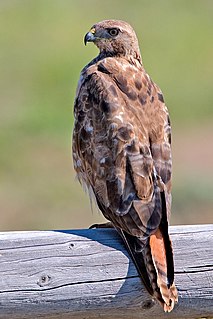
Hawks are a group of medium-sized diurnal birds of prey of the family Accipitridae. Hawks are widely distributed and vary greatly in size.

Bird migration is the regular seasonal movement, often north and south along a flyway, between breeding and wintering grounds. Many species of bird migrate. Migration carries high costs in predation and mortality, including from hunting by humans, and is driven primarily by availability of food. It occurs mainly in the northern hemisphere, where birds are funneled on to specific routes by natural barriers such as the Mediterranean Sea or the Caribbean Sea.

The tundra swan is a small Holarctic swan. The two taxa within it are usually regarded as conspecific, but are also sometimes split into two species: Bewick's swan of the Palaearctic and the whistling swan proper of the Nearctic. Birds from eastern Russia are sometimes separated as the subspecies C. c. jankowskii, but this is not widely accepted as distinct, with most authors including them in C. c. bewickii. Tundra swans are sometimes separated in the subgenus Olor together with the other Arctic swan species.

The Arctic tern is a tern in the family Laridae. This bird has a circumpolar breeding distribution covering the Arctic and sub-Arctic regions of Europe, Asia, and North America. The species is strongly migratory, seeing two summers each year as it migrates along a convoluted route from its northern breeding grounds to the Antarctic coast for the southern summer and back again about six months later. Recent studies have shown average annual roundtrip lengths of about 70,900 km (44,100 mi) for birds nesting in Iceland and Greenland and about 90,000 km (56,000 mi) for birds nesting in the Netherlands. These are by far the longest migrations known in the animal kingdom. The Arctic tern flies as well as glides through the air. It nests once every one to three years ; once it has finished nesting it takes to the sky for another long southern migration.

Reverse migration also called reverse misorientation is a phenomenon in bird migration where a bird will fly in the opposite direction of what is species typical during the migration time.

The white-rumped sandpiper is a small shorebird that breeds in the northern tundra of Canada and Alaska. This bird can be difficult to distinguish from other similar tiny shorebirds; these are known collectively as "peeps" or "stints".

The common yellowthroat is a New World warbler. It is an abundant breeder in North America, ranging from southern Canada to central Mexico. The genus name Geothlypis is from Ancient Greek geo, "ground", and thlupis, an unidentified small bird; thlypis is often used in the scientific names of New World warblers. The specific trichas is also from Greek; trikhas is a kind of thrush, the word being derived from trikhos, "hair".
The British avifauna consists of the birds which have occurred in Great Britain. This article is a general discussion of the topic. A full species list can be found at List of birds of Great Britain.
High Island is an Unincorporated community located in the Bolivar Peninsula census-designated place, Galveston County, Texas, United States. The community is located in the extreme eastern part of the county on Bolivar Peninsula, less than one mile from Chambers County and less than two miles from Jefferson County. As of 2000, 500 people resided in High Island. The 2010 census did not record a population for High Island.
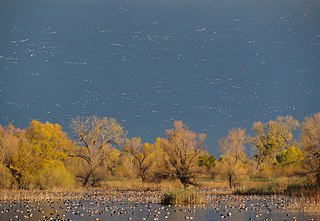
A flyway is a flight path used by large numbers of birds while migrating between their breeding grounds and their overwintering quarters. Flyways generally span continents and often pass over oceans. Although applying to any species of migrating bird, the concept was first conceived and applied to waterfowl and shore birds. The flyways can be thought of as wide arterial highways to which the migratory routes of different species are tributaries. An alternative definition is that a flyway is the entire range of a migratory bird, encompassing both its breeding and non-breeding grounds, and the resting and feeding locations it uses while migrating. There are four major north/south flyways in North America and six covering Eurasia, Africa and Australasia.

Vanessa cardui is a well-known colourful butterfly, known as the painted lady, or formerly in North America as the cosmopolitan.
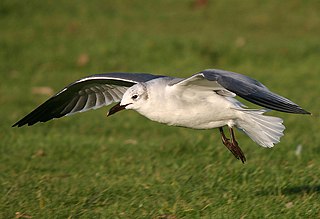
Vagrancy is a phenomenon in biology whereby individual animals appear well outside their normal range; individual animals which exhibit vagrancy are known as vagrants. The term accidental is sometimes also used. There are a number of factors which might cause an individual to become a vagrant—genetic factors and weather conditions are two—but the causes are overall poorly understood. Vagrancy can be a precursor to colonisation if individuals survive.
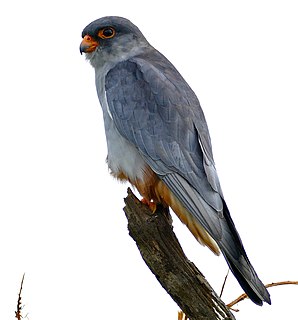
The Amur falcon is a small raptor of the falcon family. It breeds in south-eastern Siberia and Northern China before migrating in large flocks across India and over the Arabian Sea to winter in Southern Africa. It was earlier treated as a subspecies of the red-footed falcon and known as the eastern red-footed falcon. Males are dark grey with reddish brown thighs and undertail coverts; reddish orange eye-ring, cere, and feet. Females are duller above, with dark scaly markings on white underparts, an orange eye ring, cere, and legs. Only a pale wash of rufous is visible on their thighs and undertail coverts. Their diet consists mainly of insects, such as termites; during migration over the sea, they are thought to feed on migrating dragonflies.
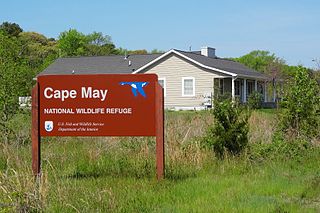
The Cape May National Wildlife Refuge is a protected area on the Cape May Peninsula in Cape May County, New Jersey. It is part of the National Wildlife Refuge System and managed by the United States Fish and Wildlife Service. Established in January 1989 with 90 acres (0.36 km2) acquired from the Nature Conservancy, it has since grown to more than 11,000 acres (45 km2) in size, and plans call for its further expansion to more than 21,200 acres (86 km2). It comprises three distinct and disjunct units: the Delaware Bay Division, the Great Cedar Swamp Division, and the Two Mile Beach Unit. Located in the Middle Atlantic coastal forests ecoregion, the cape provides habitat for large numbers of migratory birds.

Insect migration is the seasonal movement of insects, particularly those by species of dragonflies, beetles, butterflies and moths. The distance can vary with species and in most cases these movements involve large numbers of individuals. In some cases the individuals that migrate in one direction may not return and the next generation may instead migrate in the opposite direction. This is a significant difference from bird migration.
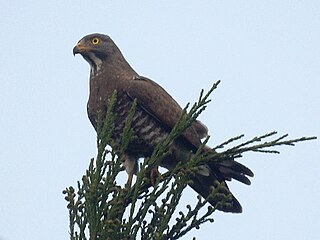
The grey-faced buzzard is an Asian bird of prey. It is typically between 41 and 46 cm in length, making it a medium-sized raptor. It breeds in East Russia, North China, Korea, and Japan, and winters in South-east Asia.

Cuspate forelands, also known as cuspate barriers or nesses in Britain, are geographical features found on coastlines and lakeshores that are created primarily by longshore drift. Formed by accretion and progradation of sand and shingle, they extend outwards from the shoreline in a triangular shape. Some cuspate forelands may be stabilised by vegetation, while others may migrate down the shoreline. Because some cuspate forelands provide an important habitat for many flora and fauna, effective management is required to reduce the impacts from both human activities and physical factors such as climate change and sea level rise.

Animal migration is the relatively long-distance movement of individual animals, usually on a seasonal basis. It is the most common form of migration in ecology. It is found in all major animal groups, including birds, mammals, fish, reptiles, amphibians, insects, and crustaceans. The trigger for the migration may be local climate, local availability of food, the season of the year or for mating reasons. To be counted as a true migration, and not just a local dispersal or irruption, the movement of the animals should be an annual or seasonal occurrence, such as Northern Hemisphere birds migrating south for the winter; wildebeest migrating annually for seasonal grazing; or a major habitat change as part of their life, such as young Atlantic salmon or Sea lamprey leaving the river of their birth when they have reached a few inches in size.

Many populations of Lepidoptera migrate, sometimes long distances, to and from areas which are only suitable for part of the year. Lepidopterans migrate on all continents except Antarctica, including from or within subtropical and tropical areas. By migrating, these species can avoid unfavorable circumstances, including weather, food shortage, or over-population. In some lepidopteran species, all individuals migrate; in others, only some migrate.

Altitudinal migration is a short-distance animal migration from lower altitudes to higher altitudes and back. It is commonly thought to happen in response to climate and food availability changes as well as increasingly due to anthropogenic influence. These migrations can occur both during reproductive and non-reproductive seasons. Altitudinal avian migration is common, and can also be found in other vertebrates, and can be seen in some invertebrates.
References
- ↑ Kasper Thorup; Thomas Alerstam; Mikael Hake; Nils Kjellén (2003). "Bird orientation: compensation for wind drift in migrating raptors is age dependent". Proc. Royal Soc. Lond. B. 270 (Suppl 1): S8–S11. doi:10.1098/rsbl.2003.0014. PMC 1698035 . PMID 12952622.